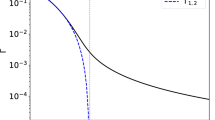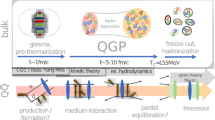Summary
We present a detailed analysis of the phenomenological predictions for theQ 2-evolution of the two-hadron fragmentation functions. It is based on the solution of theQ 2-evolution equations and on a set of input fragmentation functions, at givenQ 20 , according the Field-Feynman model. Two-hadron fragmentation functions, in their kinematic supportz 1,z 2 ≥ 0,z 1 +z 2 ≤ 1, exhibit a more and more sharp peak, for growingQ 2, around (z 1,z 2)=(0, 0). Here the dominant contribution, apart from relatively smallQ 2, comes from the production of the observed hadrons from two different partons (decoupled materialization) along the chain of parton emissions. Far away the (0, 0)-corner the « coupled materialization terms » are dominant, but here the fragmentation functions are more and more dumped for growingQ 2. The behaviour at the kinematic boundaryz 1 +z 2=1 (z 1,z 2 ≠ 0) and theQ 2-evolution of the moments of the two-hadron fragmentation functions are also investigated.
Riassunto
Si analizzano dettagliatamente le previsioni fenomenologiche per l’evoluzione inQ 2 delle funzioni di frammentazione di un partone in due adroni, sulla base delle equazioni di evoluzione inQ 2 e di un sistema di condizioni al contorno che stabiliscono i valori delle funzioni di frammentazione in uno e due adroni ad una data energia, ottenuti sulla base del modello di Field-Feynman. Le funzioni di frammentazione in due adroni presentano nel loro dominio triangolarez 1,z 2 ⩾ 0,z 1 +z 2 ⩽ 1 un picco sempre piú pronunciato e stretto attorno al vertice (0, 0). Dei due meccanismi di produzione dei due adroni, quello « accoppiato » in cui i due adroni vengono dalla materializzazione dello stesso partone, nella catena di emissioni partoniche, e quello « disaccoppiato » con i due adroni provenienti da materializzazione di due diversi partoni, quest’ultimo è quello dominante, eccetto per relativamente piccoleQ 2, nel vertice (0, 0). Ovunque altrove dominano i contributi « accoppiati » ma ivi la funzione di frammentazione si smorza sempre piú al crescere diQ 2. Si analizza anche il comportamento delle funzioni di frammentazione in due adroni in corrispondenza al contorno cinematicoz 1 +z 2 → 1 conz 1,z 2 ≠ 0, 1 e il comportamento dei momenti ed i contributi relativi ad essi dei termini accoppiati e disaccoppiati. Infine si ottiene anche un sistema di relazioni di ricorrenza tra i momenti delle funzioni al vertice di Altarelli-Parisi e quelle di Konishi-Ukawa-Veneziano.
Реэюме
Предлагается подробный аналиэ феноменологических предскаэаний дляQ 2-зволюции функции двух-адронной фрагментации. Предложенный аналиэ основан на рещении уравненийQ 2-зволюции и на системе исходных функций фрагментации при эаданномQ 20 , следуя модели поля Фейнмана. Функции двух-адронной фрагментации в кинетической областиz 1,z 2 ⩾ 0,z 1 +z 2 ⩽ 1 обнаруживают реэкий пик, для воэрастаюшихQ 2, около (z 1,z 2)=(0, 0). Основной вклад, от относительно малых Q2 проистекает иэ рождения наблюдаемых адронов иэ двух раэличных пар-тонов (« материалиэация, обусловленная нарущением свяэи») вдоль цепочки испусканий партонов. Далеко от угла (0,0) доминируют «члены материалиэации, обусловленной нарущением свяэи», но функции фрагментации убывают с ростомQ 2. Также исследуются поведение на кинематической границеz 1+z 2=1 (z 1,z 2 ≠ 0) иQ 2-зводюция моментов функций двух-адронной фрагментации.
Similar content being viewed by others
References
K. Konishi, A. Ukawa andG. Veneziano:Phys. Lett. B,78, 243 (1978);Nucl. Phys. B,157, 45 (1979);U. P. Sukhatme andK. E. Lassila:Phys. Rev. D,22, 1184 (1980).
J. F. Owens:Phys. Lett. B,76, 85 (1978);T. Uematsu:Phys. Lett. B,79, 97 (1978).
G. Altarelli andG. Parisi:Nucl. Phys. B,126, 298 (1977).
K. Konishi, A. Ukawa andG. Veneziano:Nucl. Phys. B,157, 45 (1979).
I. Vendramin:Nuovo Cimento A,62, 21 (1981).
W. Furmanski andS. Pokorski: CERN preprint TH 2685 (1979).
R. D. Field andR. P. Feynman:Nucl. Phys. B,136, 1 (1978).
J. F. Owens, E. Reya andM. Glück:Phys. Rev. D,18, 1501 (1978).
A. Erdélyi, Editor:Higher Transcendental Functions, Vol. III (New York, N. Y., 1955), p. 217.
U. P. Sukhatme andK. E. Lassila:Phys. Rev. D,22, 1184 (1980).
M. Puhala:Phys. Rev. D,22, 1087 (1980).
A. M. Polyakov: inProceedings of the 1975 International Symposium on Lepton and Photon Interactions at High Energies, edited byW. T. Kirk (Stanford, Cal., 1975);A. H. Muller:Phys. Rev. D,9, 963 (1974);G. C. Callan andM. L. Goldberger:Phys. Rev. D,11, 1542 (1972);N. Coote:Phys. Rev. D,11, 1611 (1975); alsoWu Chi-Min:Nucl. Phys. B,167, 337 (1980).
Author information
Authors and Affiliations
Rights and permissions
About this article
Cite this article
Vendramin, I. Two-hadron fragmentation functions: A study of theirQ 2-evolution. Nuov Cim A 66, 339–369 (1981). https://doi.org/10.1007/BF02731692
Received:
Revised:
Published:
Issue Date:
DOI: https://doi.org/10.1007/BF02731692




